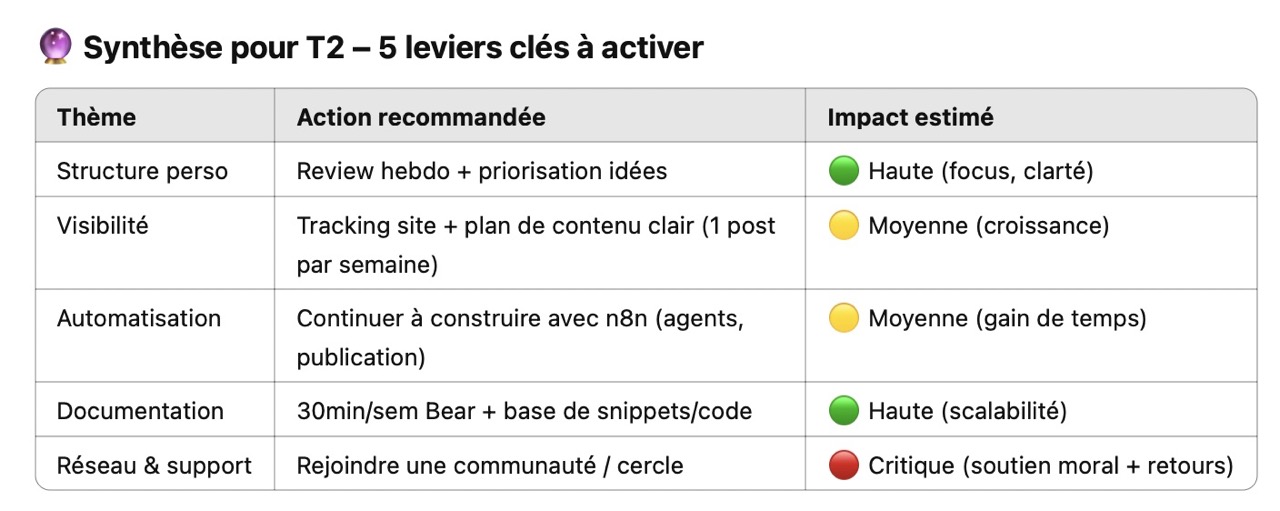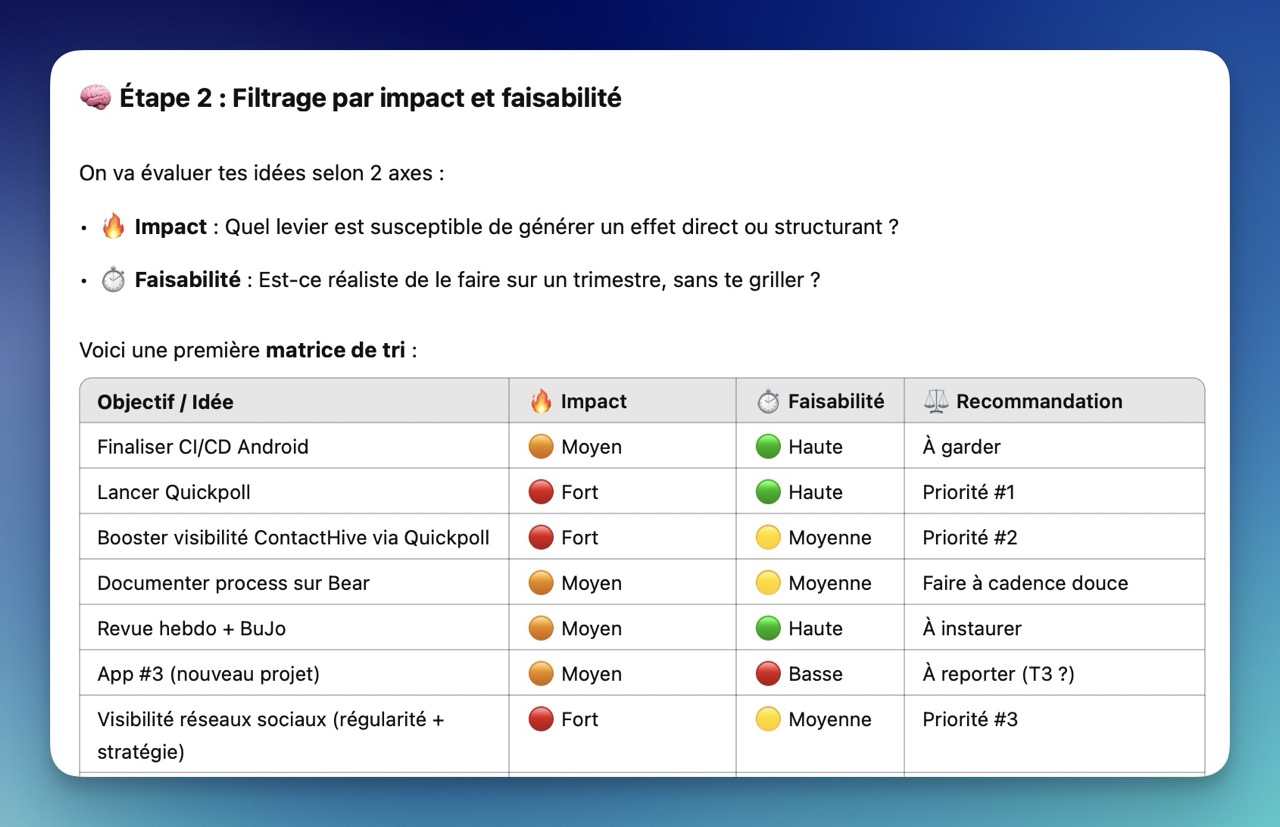Comment j’ai structuré ma revue trimestrielle grâce à l’IA

“Construis en toute liberté. Partage avec intention.”
Lorsqu’on a un objectif, il est important de s’auto-évaluer régulièrement. Dans les conseils souvent cités par les gurus de la productivité, la revue trimestrielle est quelque chose d’assez fréquent. Il est question de pouvoir reprendre les objectifs qu’on s’est fixés lors du début du trimestre, puis de voir ce qui a bien marché ou non en identifiant au passage des possibilités d’amélioration, de nouveaux objectifs si l’on a dévié, ou si d’autres priorités ou événements se sont intercalés.
##
Le syndrome de la feuille pleine 📊
Je me suis donc assis et ai pris un moment pour effectuer une rétrospective. J’étais face à un problème : je ne savais pas par où commencer. En début d’année, j’avais mis en forme un certain nombre de choses sous forme de plan et d’objectifs, et maintenant que j’étais devant cette page pleine de notes, je ne savais pas trop par où commencer. J’ai eu tout d’un coup la sensation d’être pris du syndrome de la feuille blanche comme les écrivains, sauf que moi, c’était le syndrome de la feuille pleine d’informations.
Je me suis donc dit : pourquoi ne pas utiliser l’IA pour m’aider à aller au-delà du syndrome de la feuille pleine et aller un peu plus loin qu’une première revue trimestrielle qui serait peut-être incomplète ?
Et je dois avouer que lorsque j’ai fini l’exercice, j’ai ressenti un soulagement immédiat. Car je savais que j’avais été plus loin que ce que j’aurais fait sans avoir demandé à l’IA.
##
Le processus pas à pas 🌱
Dans l’esprit des astuces que j’aimerais vouds partager dans le futur, voici comment j’ai procédé. Je me suis dit que cela pourrait aider les entrepreneurs solos qui se lancent comme moi et ne savent pas trop comment structurer leur évaluation trimestrielle.
###
1) Donner de l’input à l’IA
Afin qu’elle puisse vous aider, il faut qu’un certain nombre d’éléments soient présents. Si vous avez eu la possibilité de mettre noir sur blanc vos objectifs, ces informations seront importantes à donner au modèle afin qu’il puisse vous aider. En plus des objectifs (ou toute autre information pertinente pour l’évaluation), il faudra lui donner le prompt suivant :
Agis en tant que coach évaluateur : sur base du document que je te donne en annexe, j’aimerais que tu m’aides à préparer ma rétrospective du Trimestre 1 de 2025. Tu vas me poser des questions afin de pouvoir m’auto-évaluer, ok ?
Voici sa réponse :

###
2) Répondre aux questions et affiner 🤝
Le modèle m’a ensuite donné un certain nombre de questions en lien avec les informations que je lui avais fournies. Après avoir répondu à ces questions et les lui avoir transmises dans la conversation, il a pu consolider les informations dans une réponse en effectuant un résumé de ce qu’il avait compris et m’a proposé d’avancer.
Astuce : Si le LLM ne suit pas la même logique, il est possible de le guider. Avec moi, ChatGPT a pris l’habitude d’aller plus loin grâce à quelques petites modifications dans son comportement.

Je lui ai proposé de continuer l’analyse car il s’agit de la partie la plus importante à ce stade.
###
3) Obtenir des pistes concrètes pour le trimestre suivant ⚡️
En fin d’analyse, il m’a même proposé quelques pistes pour Q2 avec potentiellement un impact estimé pour chacune d’elles :

##
Backstage : Les ajustements nécessaires
À ce niveau-là, je n’étais pas tout à fait d’accord avec son analyse et ses conclusions. J’ai dû lui redonner un contexte plus large (puisque j’avais oublié de lui fournir au début des éléments comme, par exemple, mes objectifs annuels) ainsi que les objectifs et pistes auxquels j’avais réfléchi depuis la création de mes objectifs en début de trimestre.
Leçon apprise : Donnez dès le départ le maximum d’informations à l’IA pour éviter les allers-retours.
Pour vraiment tout dire, je suis souvent attiré par des objets brillants le long de la route et j’ai tendance à me disperser dans mes idées et ne rien faire au final. J’ai donc transmis cette information au modèle afin qu’il la prenne en compte :

##
Résultats concrets 📊
Et sur cette base, j’ai obtenu une ébauche avec des objectifs pour T2 qui, après encore quelques échanges, m’a donné un tableau d’objectifs à suivre pour le deuxième trimestre (juste après la première version qu’il m’avait proposée) :

La dernière étape de cette discussion a été de déterminer un planning théorique à suivre de manière hebdomadaire afin de ne pas se perdre.
##
Mise en garde pour les développeurs indépendants
Attention, ceci reste un plan pour vous aider à bien structurer les semaines suivantes, mais il est important de ne pas suivre aveuglément un plan sur 3 mois, jour pour jour, et ce pour plusieurs raisons :
- Il y a toujours des challenges et obstacles qui peuvent survenir
- Il est possible qu’une opportunité vienne tout bouleverser
- Vous pourriez vous rendre compte qu’au final, la direction que vous avez prise n’est pas la bonne et vous devez pivoter ou vous réajuster à la situation.
Et voilà comment j’ai pu prendre un avantage certain face à quelqu’un qui aurait navigué à vue pour effectuer sa rétrospective.
##
L’IA remplace-t-elle le coach humain?
Du coup, peut-on dire que l’IA a encore tué un type de job ? J’ai envie de croire que non, car des évaluateurs, coachs et mentors seront toujours nécessaires. D’ailleurs, je suis à la recherche d’un coach qui pourra m’aider à passer au niveau supérieur en termes d’entrepreneuriat et de visibilité. Si vous connaissez quelqu’un qui pourrait m’aider, faites-le-moi savoir.
Si vous avez aimé ce type de contenu sur l’organisation des développeurs et entrepreneurs indépendants, n’hésitez pas à vous inscrire à ma newsletter ou à me suivre sur les réseaux sociaux afin que je puisse vous partager encore plus d’astuces pour “construire en toute liberté et partager avec intention.”
Bien à vous, Alessandro
📬 Vous souhaitez recevoir d’autres conseils pratiques pour les solo entrepreneurs? Inscrivez-vous à ma newsletter via le formulaire ici en bas de page
#
English version of the article
#
How I Structured My Quarterly Review Using AI
“Build with freedom. Share with intention.”
When you have a goal, it’s important to regularly self-evaluate. Among the advice often cited by the gurus of the productivity, the quarterly review is quite common. It’s about revisiting the objectives you set at the beginning of the quarter, then seeing what worked well or not, identifying opportunities for improvement, new objectives if you’ve deviated, or if other priorities or events have intervened.
##
The Full Page Syndrome 📊
So I sat down and took a moment to conduct a retrospective. I faced a problem: I didn’t know where to start. At the beginning of the year, I had formatted a number of things in the form of a plan and objectives, and now that I was in front of this page full of notes, I wasn’t quite sure where to begin. I suddenly had the feeling of being struck with the blank page syndrome like writers, except in my case, it was the syndrome of a page full of information.
So I thought: why not use AI to help me go beyond the full page syndrome and go a little further than a first quarterly review that might be incomplete?
And I must admit that when I finished the exercise, I felt immediate relief. Because I knew I had gone further than what I would have done without asking AI for help.
##
The Step-by-Step Process 🌱
In the spirit i would like to regularly share with you, here’s how I proceeded. I thought this could help solo entrepreneurs who are starting out like me and aren’t quite sure how to structure their quarterly evaluation.
###
1) Providing Input to the AI
For it to help you, certain elements need to be present. If you’ve had the opportunity to put your objectives in writing, this information will be important to give to the model so it can help you. In addition to the objectives (or any other information relevant to the evaluation), you’ll need to give it the following prompt:
Act as an evaluating coach: based on the document I’m giving you as an attachment, I’d like you to help me prepare my retrospective for Quarter 1 of 2025. You’ll ask me questions to help me self-evaluate, okay?
Here’s its response:

###
2) Answering Questions and Refining 🤝
The model then gave me a number of questions related to the information I had provided. After answering these questions and sending them back in the conversation, it was able to consolidate the information in a response by summarizing what it had understood and suggested ways to move forward.
Tip: If the LLM doesn’t follow the same logic, it’s possible to guide it. With me, ChatGPT has gotten used to going further thanks to a few small modifications in its behavior.

I suggested it continue the analysis as this is the most important part at this stage.
###
3) Getting Concrete Ideas for the Next Quarter ⚡️
At the end of the analysis, it even suggested some directions for Q2 with a potential estimated impact for each:

##
Backstage: Necessary Adjustments
At this level, I didn’t fully agree with its analysis and conclusions. I had to give it a broader context (since I had forgotten to provide elements such as my annual objectives at the beginning) as well as the objectives and ideas I had been thinking about since creating my objectives at the beginning of the quarter.
Lesson learned: Give the AI as much information as possible from the start to avoid back-and-forth.
To be completely honest, I’m often attracted to shiny objects along the way and tend to scatter my ideas and end up not doing anything. So I passed this information to the model so it could take it into account:

##
Concrete Results 📊
And on this basis, I obtained a draft with objectives for Q2 which, after a few more exchanges, gave me a table of objectives to follow for the second quarter (right after the first version it had proposed to me):

The last step of this discussion was to determine a theoretical weekly schedule to follow in order not to get lost.
##
Warning for Independent Developers
Be careful, this remains a plan to help you structure the following weeks properly, but it’s important not to blindly follow a 3-month plan, day by day, for several reasons:
- There are always challenges and obstacles that can arise
- It’s possible that an opportunity will come along and change everything
- You might realize that ultimately, the direction you’ve taken isn’t the right one and you need to pivot or readjust to the situation.
And that’s how I was able to gain a definite advantage over someone who would have navigated by sight to conduct their retrospective.
##
Does AI Replace the Human Coach?
So, can we say that AI has killed another type of job? I want to believe that’s not the case, because evaluators, coaches, and mentors will always be necessary. In fact, I’m looking for a coach who can help me take it to the next level in terms of entrepreneurship and visibility. If you know someone who could help me, please let me know.
If you liked this type of content on the organization of independent developers and entrepreneurs, don’t hesitate to subscribe to my newsletter or follow me on social media so that I can share even more tips with you to “build with freedom and share with intention.”
Best regards, Alessandro
📬 Want to receive more practical advice for solo entrepreneurs? Sign up for my newsletter via the form at the bottom of this page